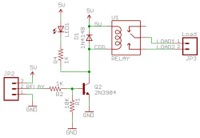Difference between revisions of "Relay"
m (Text replacement - "http://nordan.daynal.org" to "https://nordan.daynal.org") |
m (Text replacement - "http://" to "https://") |
||
| Line 3: | Line 3: | ||
==Origin== | ==Origin== | ||
[https://nordan.daynal.org/wiki/index.php?title=English#ca._1100-1500_.09THE_MIDDLE_ENGLISH_PERIOD Middle English], set of fresh hounds, from ''relayen'' | [https://nordan.daynal.org/wiki/index.php?title=English#ca._1100-1500_.09THE_MIDDLE_ENGLISH_PERIOD Middle English], set of fresh hounds, from ''relayen'' | ||
| − | *[ | + | *[https://en.wikipedia.org/wiki/17th_century 1651] |
==Definitions== | ==Definitions== | ||
*1a : a supply (as of horses) arranged beforehand for successive relief | *1a : a supply (as of horses) arranged beforehand for successive relief | ||
| Line 15: | Line 15: | ||
A '''relay''' is an [[electrically]] operated switch. Many relays use an [[electromagnet]] to operate a switching [[mechanism]] mechanically, but other operating principles are also used. Relays are used where it is [[necessary]] to control a [[circuit]] by a low-power [[signal]] (with complete electrical isolation between control and controlled circuits), or where several circuits must be controlled by one signal. The first relays were used in long distance telegraph circuits, repeating the [[signal]] coming in from one circuit and re-transmitting it to another. Relays were used extensively in telephone exchanges and early [[computers]] to perform [[logical]] operations. | A '''relay''' is an [[electrically]] operated switch. Many relays use an [[electromagnet]] to operate a switching [[mechanism]] mechanically, but other operating principles are also used. Relays are used where it is [[necessary]] to control a [[circuit]] by a low-power [[signal]] (with complete electrical isolation between control and controlled circuits), or where several circuits must be controlled by one signal. The first relays were used in long distance telegraph circuits, repeating the [[signal]] coming in from one circuit and re-transmitting it to another. Relays were used extensively in telephone exchanges and early [[computers]] to perform [[logical]] operations. | ||
| − | A type of relay that can handle the high [[power]] required to directly [[control]] an electric motor or other loads is called a [ | + | A type of relay that can handle the high [[power]] required to directly [[control]] an electric motor or other loads is called a [https://en.wikipedia.org/wiki/Contactor contactor]. [https://en.wikipedia.org/wiki/Solid-state_relay Solid-state relays] control power [[circuits]] with no moving parts, instead using a semiconductor device to perform switching. Relays with calibrated operating characteristics and sometimes multiple operating coils are used to protect electrical circuits from overload or faults; in modern electric power systems these [[functions]] are performed by digital instruments still called "[https://en.wikipedia.org/wiki/Protective_relay protective relays]".[https://en.wikipedia.org/wiki/Relay] |
[[Category: Physics]] | [[Category: Physics]] | ||
Latest revision as of 02:37, 13 December 2020
Origin
Middle English, set of fresh hounds, from relayen
Definitions
- 1a : a supply (as of horses) arranged beforehand for successive relief
- 2a : a race between teams in which each team member successively covers a specified portion of the course
- b : one of the divisions of a relay
- 3: an electromagnetic device for remote or automatic control that is actuated by variation in conditions of an electric circuit and that operates in turn other devices (as switches) in the same or a different circuit
- 4: servomotor
- 5: the act of passing along (as a message or ball) by stages; also : one of such stages
Description
A relay is an electrically operated switch. Many relays use an electromagnet to operate a switching mechanism mechanically, but other operating principles are also used. Relays are used where it is necessary to control a circuit by a low-power signal (with complete electrical isolation between control and controlled circuits), or where several circuits must be controlled by one signal. The first relays were used in long distance telegraph circuits, repeating the signal coming in from one circuit and re-transmitting it to another. Relays were used extensively in telephone exchanges and early computers to perform logical operations.
A type of relay that can handle the high power required to directly control an electric motor or other loads is called a contactor. Solid-state relays control power circuits with no moving parts, instead using a semiconductor device to perform switching. Relays with calibrated operating characteristics and sometimes multiple operating coils are used to protect electrical circuits from overload or faults; in modern electric power systems these functions are performed by digital instruments still called "protective relays".[1]
